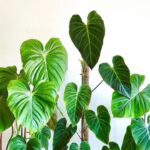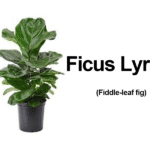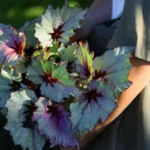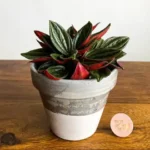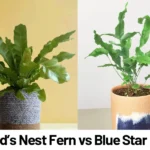Meet Calathea crocata: The Eternal Flame Plant
Calathea crocata, often known as the Eternal Flame plant, is a stunning tropical houseplant known for its velvety dark-green leaves and fiery, flame-like orange flowers. Native to the South American rainforests of Brazil and surrounding regions, this plant belongs to the Marantaceae family—commonly referred to as the prayer plant family. Its name “crocata” refers to the saffron-colored blossoms that resemble glowing candles, adding an exotic touch to indoor foliage collections.
Perfect for intermediate plant owners or beginners eager to learn, Calathea crocata offers both ornamental foliage and seasonal blooms when provided with the right care. In this guide, we’ll cover everything from optimal lighting and humidity to common issues and propagation tips so your Eternal Flame can thrive indoors.
Light Requirements for Healthy Growth
One of the most crucial factors in keeping Calathea crocata happy is providing the right amount of light. Native to the shaded layers of the rainforest understory, this plant thrives in soft, indirect light.
- Best Light: Bright, indirect sunlight is ideal. A north- or east-facing window is often perfect.
- Too Much Light: Direct sun can scorch the leaves, causing them to fade or develop crispy edges.
- Too Little Light: Low light will lead to slower growth and reduced blooming potential.
Tip: If your plant isn’t flowering, it may not be getting enough light. Try moving it to a brighter spot—but avoid harsh direct sunlight.
Ideal Watering Routine
Calathea crocata enjoys evenly moist soil, but like most tropical plants, it despises soggy roots. Consistency is key.
- Water when the top inch of soil feels dry. Use your finger to check before each watering.
- Use room-temperature, filtered or distilled water. Tap water with fluoride or chlorine may damage the plant’s sensitive roots and leaf tips.
- Ensure proper drainage. Pots with drainage holes and a loose soil mix are important to prevent puddling water at the roots.
Tip: Yellowing leaves are often a sign of overwatering, while crispy brown edges may indicate underwatering or poor humidity.
Humidity and Temperature Needs
As a rainforest native, Calathea crocata demands high humidity to maintain its beautiful foliage and encourage blooms. When conditions are humid and warm, this plant is most likely to thrive—and even flower indoors.
- Humidity: Aim for at least 50–60% humidity. Higher humidity (above 60%) supports healthier leaves and flower development.
- How to Increase Humidity:
- Use a room humidifier.
- Group plants together to create a microclimate.
- Place the Calathea on a pebble tray filled with water (ensure the pot base isn’t submerged).
- Temperature: Keep indoor temperatures between 65–80°F (18–27°C). Avoid cold drafts and sudden temperature changes.
Tip: Calatheas are sensitive to temperature drops. Keep them away from open windows or air-conditioning vents, especially during winter.
Soil and Fertilization Tips
The right soil and nutrition are vital for maintaining vibrant foliage and encouraging the perennial blossoms of Calathea crocata.
- Soil Mix: A lightweight, well-draining mix works best. Consider combining:
- Two parts peat or coco coir
- One part perlite or coarse sand
- One part orchid bark or compost
- Fertilizer: During growing season (spring and summer), feed monthly with a balanced, diluted liquid houseplant fertilizer (e.g. 10-10-10 or 20-20-20).
- Don’t fertilize in winter: The plant enters a dormant phase and doesn’t need extra nutrition.
Tip: Excess fertilizer can cause root burn. Always dilute to half strength and monitor for any mineral buildup on the soil surface.
Getting the Eternal Flame to Bloom
The standout feature of Calathea crocata is its bold, saffron-orange flowers that can appear during the spring or summer. However, blooming indoors requires optimal conditions and some patience.
- Ensure consistent bright, indirect light.
- Maintain high humidity and warm temperatures.
- Fertilize monthly during the active growing season.
- Avoid stress factors like cold drafts, low light, or irregular watering schedules.
With dedication, your plant may reward you with vibrant orange blooms that rise above its dark green leaves like little eternal flames.
Common Problems and How to Fix Them
Leaf Curling or Drooping
Curling leaves typically signal low humidity, underwatering, or temperature stress. Check your plant’s environment and adjust accordingly.
Brown Leaf Edges
Often caused by dry air or exposure to chemicals in tap water. Use filtered water and increase humidity with a humidifier or pebble tray.
No Flowers
Lack of blooms is usually the result of too little light or inconsistent care. Evaluate your plant’s conditions—especially light and feeding routine.
Pest Issues
While generally pest-resistant, Calathea crocata can occasionally fall victim to:
- Spider mites: Look for webbing and yellow speckles. Increase humidity and treat with neem oil.
- Mealybugs: White, cottony spots on leaves. Use insecticidal soap or rubbing alcohol on affected areas.
Tip: Keep your plant’s leaves clean by wiping them gently with a damp cloth every week. This not only keeps it looking pretty but deters pests too.
Repotting and Propagation
Calathea crocata prefers to be slightly root-bound and doesn’t need frequent repotting. Every 2–3 years is usually sufficient, or when roots start growing out of the drainage holes.
- Best time to repot: Early spring, before the plant enters its growth phase.
- Pot size: Choose a pot just 1–2 inches larger than the current one to avoid overwatering issues.
Propagation
This plant is best propagated through division rather than cuttings:
- Remove the plant from its pot and gently separate the root ball into sections, ensuring each has roots and foliage.
- Replant divisions into small pots with fresh, moist soil mix.
- Keep in a warm, humid environment for a few weeks until they establish.
Tip: Propagation is best done during the growing season to encourage quick recovery and growth.
Conclusion: A Worthwhile Choice for Indoor Gardeners
Calathea crocata adds year-round charm with its dramatic foliage and infrequent—but dazzling—orange blooms. While it does require a bit more attention than hardier houseplants, the rewards are more than worth it. With consistent humidity, indirect light, and proper watering, this Eternal Flame will flourish as a highlight in your indoor plant collection.
Whether you’re a houseplant enthusiast who loves collecting unique specimens, or a beginner ready to take your indoor gardening to the next level, Calathea crocata is a rewarding companion. Nurtured with care, it will add warmth and vibrancy to your space—not just with its colors, but also with the joy it brings to daily plant parenting.
References
- Chadwick, C., & Keen, A. (2011). The House Plant Expert (Revised ed.). Transworld Publishers.
- Hessayon, D. G. (2008). The Houseplant Expert. Expert Books.
- Florida Master Gardener Program. (2020). Calathea Care Guide. University of Florida IFAS Extension.


